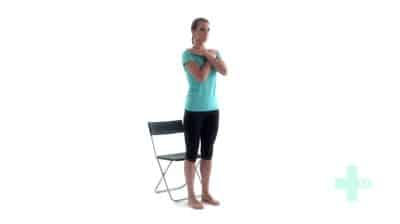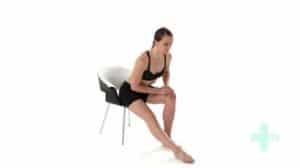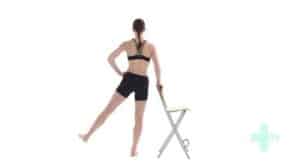Finding the best exercises for your hip or knee pain can be tough. This has been made even tougher due to the recent COVID-19 pandemic.
Maybe your local heated pools that are necessary for you to maintain your mobility has been closed. Or your gym? Or perhaps you just aren’t able to be as active as normal because of social distancing.
Take a look at these exercises and strategies you can still do to stay active and control your pain during this pandemic.
1) SIT TO STAND

Find a normal sized chair. Bend your knees to 90 degrees. Cross both arms and then lean forward & stand up.
Too Easy? Try a lower chair or try an asymmetric Sit to Stand (bend your knee with pain back further than the other one and repeat the exercise).
Too Hard? Make the seat higher like a stool or some cushions.
Performing a Sit to Stand is the BEST exercise for knee pain (especially for people with osteoarthritis). This knee exercise strengthens your quadriceps muscles which are vital for taking load off your knees and relieving pain.
2) BRIDGE

Bend both your knees back whilst laying on a bed, yoga mat or couch. Push through your heels and lift up your bottom.
Too Easy? Try a single leg bridge or do it with both your feet on a swiss ball.
Too Hard? Begin by just clenching your gluteal muscles or start with just a pre-lift, then build up the exercise from there.
Bridging is a great strengthening exercise for knee pain. As well as strengthening your knees, it also helps exercise your hips, back and core muscles.
3) HAMSTRING STRETCH

The seated hamstring stretch is best to help you to straighten your knee and reduce cramps in the back of your leg.
Too Easy? Try to do this in standing
Too Hard? Do this laying on your back with a towel under your foot pulling your leg upwards.
4) CALF RAISE

Standing, holding onto a wall or chair, keep your legs straight and go up on your tippy toes. Repeat
Too Easy? Try single leg
Too Hard? Do this sitting down
Often, people with Knee or Hip Osteoarthritis experience cramping in the backs of their legs, research suggests that the stronger you are in your calf muscles, the less pain and cramping you will have. Calf Raises are also great to boost circulation!
5) STANDING HIP ABDUCTION

Standing, holding onto a wall or chair, stand on one leg and kick the other out to the side. Hold for 3 seconds and repeat. Stay Upright
Too Easy? Try adding resistance from a theraband or ankle weight
Too Hard? Do this laying on your side and kick up to the roof.
Hip abduction is one of the greatest hip and leg strengthening exercises you can do. The muscles on the outside of your hip control your knee movement, helping your knee to track better and cause less pain!
WHAT IF THESE EXERCISES ARE TOO PAINFUL FOR MY KNEE?
Pain with exercise is common with knee osteoarthritis. As long as you keep your pain to mild on a pain scale or 2/10 (10 being really painful) you will be fine and more importantly you won’t be doing more damage to your knee or increasing pain in your knee for the next day.
All the above exercises also have options if you are finding it difficult to keep your pain below 2/10. If you can’t do these modified exercises with minimal pain in your knee, just skip it and move on.
DOES EXERCISE MAKE KNEE OSTEOARTHRITIS WORSE?
The answer is an emphatic NO.
In fact, your knee osteoarthritis is more likely to progress (confirmed by MRI) if you don’t exercise than if you do.
You just need to do it right!
Knee Osteoarthritis is no longer seen as a “wear and tear” condition.
It is now believed that the impact from exercise and the joint loading is what nourishes the joint cartilage affected by osteoarthritis.
This loaded exercise pushes out old synovium fluid from your knee cartilage and allows it to soak up new joint fluid with new nutrients which help restore and repair.
ALTHOUGH: it is likely that too much impact may be the trigger for people with knee pain from osteoarthritis.
HOW OFTEN SHOULD I EXERCISE FOR MY KNEE PAIN?
The international guidelines recommend exercising 30 minutes a day most days of the week as well as twice a week for strength training.
Although as loaded exercise for knee pain is good for your joint cartilage, rest and recovery from loaded exercise is just as important.
For example, you may alternate doing the exercises above with exercise that doesn’t involve much impact or weight bearing.
**Please note: this is an EXAMPLE exercise program and it is not intended for general use or as professional advice. It is always recommended to consult your GP prior to starting an exercise regime.

